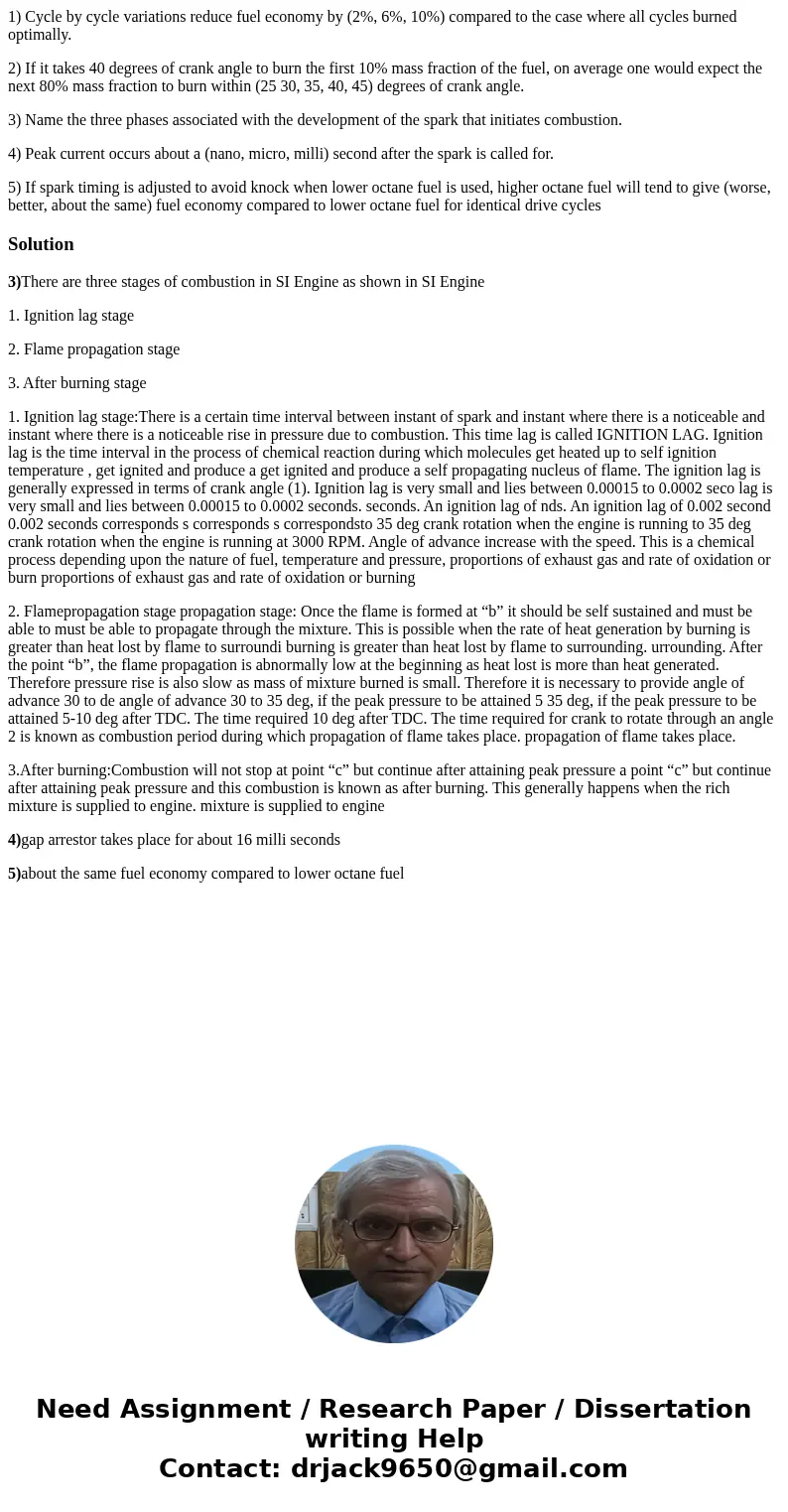1 Cycle by cycle variations reduce fuel economy by 2 6 10 co
1) Cycle by cycle variations reduce fuel economy by (2%, 6%, 10%) compared to the case where all cycles burned optimally.
2) If it takes 40 degrees of crank angle to burn the first 10% mass fraction of the fuel, on average one would expect the next 80% mass fraction to burn within (25 30, 35, 40, 45) degrees of crank angle.
3) Name the three phases associated with the development of the spark that initiates combustion.
4) Peak current occurs about a (nano, micro, milli) second after the spark is called for.
5) If spark timing is adjusted to avoid knock when lower octane fuel is used, higher octane fuel will tend to give (worse, better, about the same) fuel economy compared to lower octane fuel for identical drive cycles
Solution
3)There are three stages of combustion in SI Engine as shown in SI Engine
1. Ignition lag stage
2. Flame propagation stage
3. After burning stage
1. Ignition lag stage:There is a certain time interval between instant of spark and instant where there is a noticeable and instant where there is a noticeable rise in pressure due to combustion. This time lag is called IGNITION LAG. Ignition lag is the time interval in the process of chemical reaction during which molecules get heated up to self ignition temperature , get ignited and produce a get ignited and produce a self propagating nucleus of flame. The ignition lag is generally expressed in terms of crank angle (1). Ignition lag is very small and lies between 0.00015 to 0.0002 seco lag is very small and lies between 0.00015 to 0.0002 seconds. seconds. An ignition lag of nds. An ignition lag of 0.002 second 0.002 seconds corresponds s corresponds s correspondsto 35 deg crank rotation when the engine is running to 35 deg crank rotation when the engine is running at 3000 RPM. Angle of advance increase with the speed. This is a chemical process depending upon the nature of fuel, temperature and pressure, proportions of exhaust gas and rate of oxidation or burn proportions of exhaust gas and rate of oxidation or burning
2. Flamepropagation stage propagation stage: Once the flame is formed at “b” it should be self sustained and must be able to must be able to propagate through the mixture. This is possible when the rate of heat generation by burning is greater than heat lost by flame to surroundi burning is greater than heat lost by flame to surrounding. urrounding. After the point “b”, the flame propagation is abnormally low at the beginning as heat lost is more than heat generated. Therefore pressure rise is also slow as mass of mixture burned is small. Therefore it is necessary to provide angle of advance 30 to de angle of advance 30 to 35 deg, if the peak pressure to be attained 5 35 deg, if the peak pressure to be attained 5-10 deg after TDC. The time required 10 deg after TDC. The time required for crank to rotate through an angle 2 is known as combustion period during which propagation of flame takes place. propagation of flame takes place.
3.After burning:Combustion will not stop at point “c” but continue after attaining peak pressure a point “c” but continue after attaining peak pressure and this combustion is known as after burning. This generally happens when the rich mixture is supplied to engine. mixture is supplied to engine
4)gap arrestor takes place for about 16 milli seconds
5)about the same fuel economy compared to lower octane fuel

 Homework Sourse
Homework Sourse